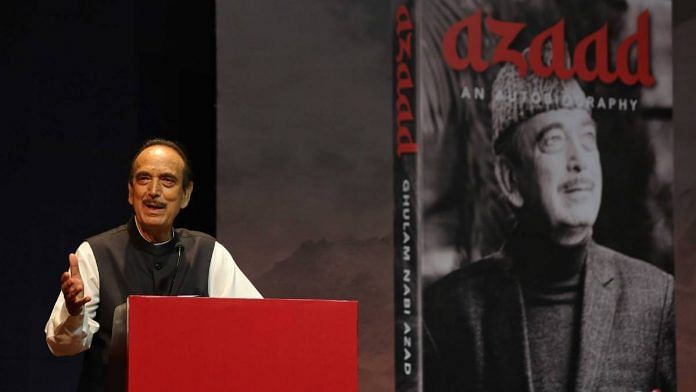New Delhi: In 2014, the then Congress president Sonia Gandhi had given a go-ahead to replace the then Assam chief minister Tarun Gogoi with Himanta Biswa Sarma, but Rahul Gandhi stalled the transition, former Congress leader Ghulam Nabi Azad has said in his autobiography, seeking to explain exactly when the party’s downfall started in the northeast.
‘Azaad — An Autobiography‘ was launched Wednesday. The book deals with Azad’s political journey and landmark moments.
In July 2014, Sarma had resigned from the Gogoi cabinet, rebelling against the latter’s leadership. He joined the BJP a year later. His entry into the BJP laid the foundation for the Congress’ decimation and the BJP’s domination in the northeast. Sarma went on to become the chief minister of Assam in 2021.
Azad, who had been sent as All India Congress Committee (AICC) observer to Assam following the political crisis caused by Sarma’s resignation as a minister, said that, after assessing the situation, Sonia Gandhi had said that it was “obvious that Sarma had a clear majority and should be the new CM”. The plan was set and Azad was set to oversee the change in guard from Gogoi to Sarma.
Azad, who has earlier served as Jammu & Kashmir chief minister and Union minister, founded the Democratic Progressive Azad Party after quitting the Congress last year.
Also Read: ‘Dynasty, casteism & regionalism’ — Modi takes aim at Congress, other parties on BJP foundation day
Sonia wanted Himanta’s elevation as CM
According to Azad, the late Tarun Gogoi, who became chief minister of Assam in 2001, had “promised” that he would step down if the party regained power for the second time.
Gogoi, he claimed, said he would pave the way for “his right-hand man” Sarma. However, the Congress won two more terms in 2006 and 2011, but Gogoi did not vacate his chair.
In 2014, when Sarma rebelled, he and his supporters were summoned to Delhi by the party. He turned up with 45-plus MLAs out of the Congress’ 78 in the house. The total strength of the Assam assembly is 120.
However, when Gogoi was asked to come or send his MLAs to Delhi, only 7 legislators turned up, according to Azad. “The remaining… MLAs” were ready to abide by the party high command’s decision, Azad said.
The situation was reported to Sonia Gandhi. “I reported the situation to Sonia ji, who remarked that it was obvious that Himanta had a clear majority and should be the new CM. She asked me to go to Assam the following day along with the general secretary in-charge and oversee the formal election of Himanta as the new leader,” writes Azad.
However, a day before Azad was set to visit Assam, Rahul Gandhi told him to meet him.
In that meeting, also attended by Tarun Gogoi and his son Gaurav Gogoi, Rahul announced that there will be no change in leadership, Azad said. When it was pointed out that Himanta had the majority MLAs, Rahul said, “Let him go”, according to Azad.
“The meeting was over. I am not sure if Rahul said this to assert himself or because he was ignorant that his decision would have far-reaching consequences, not only in the state of Assam but the entire northeast,” writes Azad.
He adds, “Himanta had been the party in-charge of the entire northeast from time to time and particularly during elections in these states, where he was very popular… the exit of one capable person sounded the death knell for the party in the entire region.”
Following Rahul’s decision, Sonia decided not to interfere. Instead, she asked Azad to request Himanta to “not rock the boat”, he writes.
This, he says, is an example of “the Congress party’s determination to destroy itself”.
‘Lack of fresh talent’
In his book, Azad attacks the Congress leadership over lack of fresh talent and stagnation in the party.
“I have to say that it (BJP) did a smart thing by copying the Congress’ old system. They change the national party presidents every two years, thus… New leaders get a chance to emerge, new regions are represented and people from different castes and communities get an opportunity to demonstrate their leadership qualities.”
The BJP has had only two party presidents since 2014, but Azad says the party has expanded its social base across the country, and one of the reasons for the same is the “system that it follows in the change of party leadership after two years or at least frequently”.
The Congress elected Mallikarjun Kharge as its president last year, after years of being under the Gandhi family.
(Edited by Geethalakshmi Ramanathan)
Also Read: ‘Is this ideology of Gandhism?’ — Scindia accuses Congress of pressuring judiciary in Rahul case



